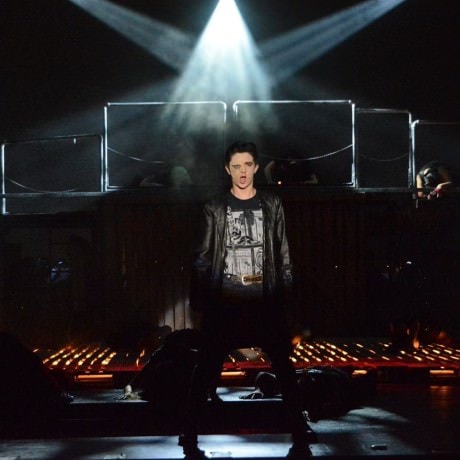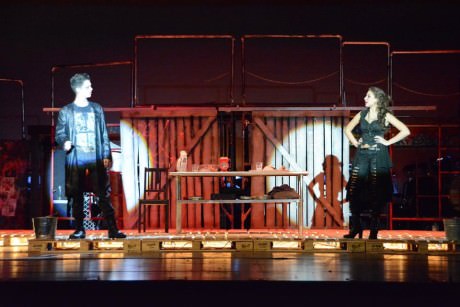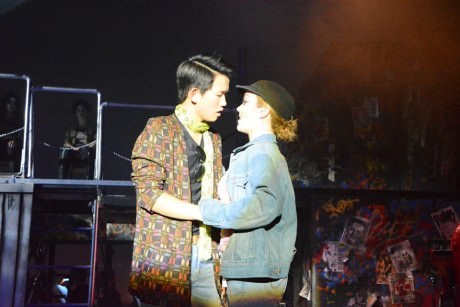Whitman Drama’s Sweeney Todd: The Demon Barber of Fleet Street (school edition) is a superb production that demonstrates the strength and ambition of the Whitman High School Theatre program. An enormous production, with complex dance and choreography, and musical numbers that are executed perfectly while actors are running up and down the professional level set. This Sweeney Todd could be on Off Broadway tomorrow – it’s that good.
Director Christopher Gerken is marking his 10th anniversary, and he has reason to celebrate this momentous occasion by directing this amazing production of Stephen Sondheim’s pie-eating masterpiece.
The excellence of the performances, direction, costumes, sets, lighting, choreography and the orchestra makes the production worthy of a long run in a larger venue. Not counting many of the parent volunteers, the program lists over 100 individuals who worked together to make this production possible.
Callum Alden (Sweeney Todd), plays a grim and embittered character whose makeup enhanced the portrayal of a damaged and deranged character. I wouldn’t have let someone who looked like that come anywhere close to me with a razor.

Sweeney Todd is determined to destroy Judge Turpin (Niko Granados), who had sent him to prison on trumped up charges and raped his wife while he was away. Now Turpin has designs on Todd’s daughter, Joanna, who Turpin had appropriated as his ward, and now hopes to marry. Todd embarks on a plan of revenge which results in quite a few other characters meeting their maker.
A successful casting innovation is the enlistment of Kaycie Goral as Ms. Lovett, who added panache to the often matronly persona in other versions of this musical. She introduced the factor of lust into the equation which previously dwelt primarily on a revenge theme.
Mrs. Lovett enables Todd to set up shop as a barber again. She sees an opportunity to both hide his murderous crimes and support her business by using his victims to stuff her meat pies (“the price of meat is so dear….”).

Alden and Goral collaborate in several duets, such as “A little Priest” in which they use puns to describe the attributes of various pies based on the vocations of their main ingredients, and there are terrifyingly terrific together. While Todd and Lovett two seem to enjoy their work, the ecstatic and ravenous response of the crowds to the pies they produce suggests that is fortunate that these two have maintained secrecy when it comes to their recipe. Otherwise the conspirators might have gotten some serious competition.

Bryan Eng (Anthony Hope) was an effective romantic lead, and his duets with Judge Turpin’s ‘daughter’ Johanna (Becky Keteltas) are poignant and accomplish some relief from the grim trajectory of the story line. Both have soaring and complex singing parts for which they are well-prepared. The transfixed audience clapped heartily for the love song “Kiss Me” between Todd’s daughter Johanna, and her sailor-suitor Anthony Hope. Niko Granados (Judge Turpin) is played in a campy fashion which insulates us from much sympathy or aversion to his manner of departure. His duet “Pretty Women” (which is later reprised) brought some lovely harmonies. Creepiness abounded in Granados’ fine performance.

Eli Wasserman (Tobias) did an athletic rendition of “Pirelli’s Miracle Elixir” in the first act, and it was very moving when he sang “Not While I’m Around” with Ms. Lovett.
Also turning in a great performance was Carly Choppin as the Beggar Woman. She was well-costumed for her part, credible as a once pretty woman, now a street beggar, and was terrifically hysterical in “City on Fire.” She kept our attention with minimal dialogue but a lot of calisthenics and loud wailing.
The director’s choice to have a female play the role of the other barber, Adolfo Pirelli (Ava Chenok) was an interesting departure, and her soaring soprano provided a welcome counterpoint. As someone attempting to run her own con game, she contributed to the portrayal of London commerce as strictly “buyer beware.”
Uniformed Cameron Perl was a corrupt and bullying official – Judge Turpin’s sidekick Beadle Bamford. This was another unethical character, with power and little incentive to pursue any kind of official justice.
The madhouse scene was exceptional as it portrayed London as a place where injustice is frequently a fact of life. This is a place where a person can be restrained with or without a real mental illness. It’s a violent and macabre place where someone’s hair can be culled for for wigs. The ensemble moved together and sang beautifully as they depicted the inmates’ nervous ticks and atavistic scratching in the Victorian-era asylum and several other scenes involving the whole company.
The gritty set made of black screens and large slate- covered ovens was offset by great lighting by Sydney Asselin, whose colorful projections provided a backdrop in a rainy scene featuring Martha Graham-style choreography.
The remarkable set design by Harry Cash and Serena Tycho was produced on site by members of the student crew. The metallic and dingy-looking buildings, stairs, house entrance and oven, sometimes shaded with atmospheric fog. recreated the London of the past. I don’t know who was responsible for the red barber chair, surely a Delorean of barber chairs.
Vocal Director Jeffrey Davidson and Orchestra Director Terry Alvey coordinated wonderful songs and dance music fthat was flawless and showcased the singers pyrotechniques. Lighting Design by Sydney Asselin and Julian Kafka is simply stunning. Sound design by Ky Mundy and Don Demember is surprising at every turn from the sound of bells, factory whistles and the slitting of throats.
Costume design by Gennie Anderson and Calem Riggs was gorgeous, and evocative in its versatility. Outfits had components of Goth, Victorian, Leather, Lace, and Camp, with abundant black sartorial creations merging various leather accessories, tights with decorative slits and runs, and outfits suggesting the plundering of vintage shops and limited access to sanitation. There was a salad of costume influences, also suggesting close observation of common student streetwear at times. I especially liked the black costumes which revealed red linings.
Makeup using massive amounts of under-eye darkening also was suggestive of a zombie takeover of the London scene, and the general deshabillee added to the ambiance of decadence as well as desperation, which has suggested to some a desire on the part of Sondheim to imply a critique of capitalism. Theresa Colston should be credited for this effective and consistent styling of the main as well as the secondary characters.
Whitman Drama’s Sweeney Todd is an ambitious achievement continuing the high standard we now expect of this talented theatre program. It’s filled with terrific performances, fine direction, jaw-dropping design, and it’s pure entertainment. Pie anyone?
Running Time: Two hours and 45 minutes, including one 15-minute intermission
Sweeney Todd: The Demon Barber of Fleet Street plays tonight and tomorrow night, November 20 and 21, 2015 at 7 pm at Walt Whitman High School – 7100 Whittier Boulevard, in Bethesda, MD. For tickets, purchase them at the door, or online.





